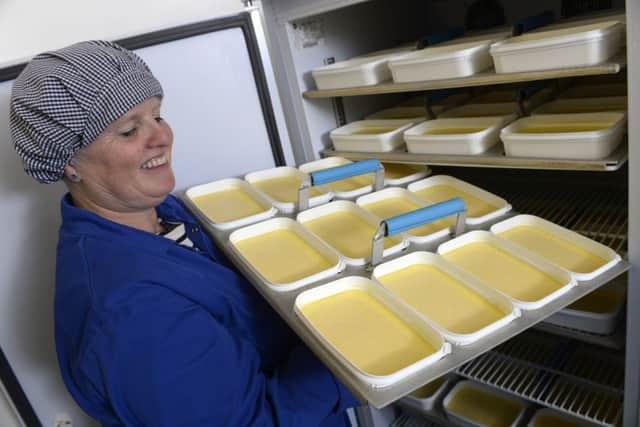Which clotted cream tea is best: Devon or Cornwall? Neither - it's Yorkshire's


All the clotted cream served at Bettys isn’t made in Devon and Cornwall as many may think, but right here in Yorkshire by Cornishwoman Sue Gaudie on the family organic dairy farm near Northallerton.
Sue moved north after meeting her husband Angus while preparing for a Young Farmers exchange trip to Canada.
Advertisement
Hide AdAdvertisement
Hide Ad“My parents were farmers in the south-west of Cornwall and I had been on the exchange to Canada the year before and so had been asked to give a talk to the next exchange trip,” says Sue. “It was there I met Angus, who asked if he could borrow £27 – he still owes me it.”


Angus took over the 60-plus dairy herd at Stamfrey Farm, near Northallerton, from his father Norman, who had been a member of the Richmond 16 group of conscientious objectors during the First World War who were locked up in Richmond Castle for refusing to join the war effort. He later taught at Askham Bryan College, near York, and then spent four years in Ghana before moving back to Yorkshire and buying Stamfrey Farm.
After meeting Sue, Angus convinced her to move to Yorkshire and they were married in 1992. They have three sons, William, 22, who has cerebral palsy, 20-year-old Sam and Jo, 18.
But by the mid-1990s the first milk crisis was hitting home.
Advertisement
Hide AdAdvertisement
Hide Ad“The cost of milk plummeted from 29p to 18p,” says Angus. “It wasn’t as bad as it is now, but we realised that we had to look at diversifying to survive. We looked at everything from a farm shop to a pet cemetery – anything that would utilise the land.”


It was when Angus visited an organic farm that he realised that that was where Stamfrey’s future lay. “Organic milk was still really quite new and there was a lot of government support and it just seemed to make sense to me,” he says, adding that it is a two-year process to be certified as an organic farm.
“It means that you can’t use artificial nitrogen on the land. Instead we use natural nitrogen which we filter through clover.”
The cows at Stamfrey are given only grass, clover and organic feed, with many of their veterinary needs managed homeopathically. By 2001 the farm was certified organic, with Angus and Sue mainly supplying wholesalers with their organic milk. But throughout this time Sue’s craving for her beloved clotted cream hadn’t abated.
Advertisement
Hide AdAdvertisement
Hide Ad“Every time anyone visited us from Cornwall they would ask if there was anything they could bring and every time I asked for clotted cream. I just couldn’t get it in Yorkshire.”
Then one day an old boyfriend of Sue’s who made clotted cream paid a visit. “I asked him where my clotted cream was. He said he hadn’t brought me any, instead he’d brought a separator and told me to make my own.”
The Gaudies swapped the separator for two Leeds United tickets, but admit to putting it in the garage and never thinking any more about it as they were still in the process of becoming organic.
Once they had made the switch Angus joined organic producers groups and at one of their meetings someone told him about a new business starting in Pickering that was wanting to sell local food to local people.
Advertisement
Hide AdAdvertisement
Hide Ad“He said he’d told them that we made organic clotted cream. We had talked about it but we’d never got round to it and what’s more we didn’t know how to make it,” says Angus.
They dusted down the separator and Sue got in touch with her granny who used to make her own clotted cream. The couple started with a small patch, using the separator to separate the cream from the whole milk straight from the cow.
“We had no idea what we were doing,” adds Angus. “It looked yellow, like clotted cream. Sue put it in an enamel dish and floated it on a bigger dish on the Aga for a few hours. When we tasted it we realised that we had something really special.”
The Gaudies took it to another organic producers meeting for people to try. “They just went bonkers for it,” says Sue.
Advertisement
Hide AdAdvertisement
Hide Ad“There’s a day in your life when you know something has changed,” says Angus. “That was it for us. We came out of there knowing we’d got something.”
They then had to set about creating a dairy, sorting out branding and packaging, and acquiring a dairy licence and environmental health certificates.
“The farm hadn’t been doing particularly well for a few years so there wasn’t any money to spend on a big processing unit,” adds Angus. “The first clotted cream cooker we had was a converted six foot by 18 inches cow trough. We carried the milk in 25-litre drums from the milking unit up to the dairy.”
It is all rather different today. The milk is pumped directly into the dairy, although they do still use the same separator, which has had a few modifications. They no longer cook the clotted cream on the Aga, using a purpose-built unit instead, although the cream is still cooked over water.
Advertisement
Hide AdAdvertisement
Hide AdSue, with the help of two part-time staff, can produce 200lb of clotted cream a day with trays of 36 tubs being made at any one time. Fifty per cent of it goes to Bettys, the rest to wholesalers or farm shops and Fodder in Harrogate.
“The first person I approached about having our clotted cream was Andrew Pern at the Star at Harome on our way back from Pickering,” says Sue. “He was awfully nice but said he already had a supplier.” Stamfrey’s now supplies the Michelin- starred restaurant and many others besides.
“The next person I thought of was Bettys. I thought they do a lot of afternoon teas and so our clotted cream would be perfect.” So, Sue being Sue, she picked up the phone to the then managing director of Bettys and asked if she’d be interested in trying her clotted cream.
“She said I needed to speak to the then executive chef, David Parker. I then got cold feet as I was worried we couldn’t actually produce the volumes they would need. I came off the phone and thought ‘whatever made me think we could supply Bettys?’ and so I didn’t make any more phone calls.”
Advertisement
Hide AdAdvertisement
Hide AdTwo years went by and the Gaudies were selling their clotted cream at farmers markets and in farm shops when Sue received a telephone call from David Parker.
“I recognised the name but couldn’t quite place it. He said he was phoning from Bettys and he’d tasted our clotted cream on four separate occasions and he wanted us to supply it.”
Whereas most suppliers would jump at the chance of a Bettys contract, Sue was still worried about the dairy’s capacity.
“I said ‘I don’t think it will be possible’ but he wouldn’t take no for an answer. He came to the farm, looked at the dairy and said ‘I’m sure we can manage it.’ I said ‘OK, so long as you don’t put it on the specials menu to go with mince pies’. He agreed.
Advertisement
Hide AdAdvertisement
Hide Ad“But then I got another phone call two weeks later from him and he said he was going to have to put it on the specials board. For the next three years he rang me every November to say it was going on the specials board. I asked him whether he rang every supplier that way, and he said no, just me.”
Angus now has 150 organic milking cows who wander the stunning fields that surround Stamfrey. From Sue’s dairy overlooking the North York Moors, the cows can be seen grazing the fields beyond the farmhouse’s idyllic garden.
With the increase in clotted cream production there was an increase in the amount of skimmed milk left over when the cream was separated.
Most of the organic milk goes into a co-operative which exports as far afield as China, but in 2007 the Gaudies also decided to try their hand at making low-fat pouring yoghurt out of some of the organic skimmed milk.
Advertisement
Hide AdAdvertisement
Hide AdAngus is a true Yorkshireman and doesn’t like waste. “We believe the yoghurt has massive potential,” he says. “It is just 0.4 per cent fat – very different from the clotted cream which is 62 per cent fat.”
It may have a high fat content but this artisan product still made in a very traditional way is an indulgent treat,
“We have to taste test the clotted cream,” laughs Sue. “People ask if I ever get sick of it, but I never do. I just love it.”
But which does Sue put on the scone first – the jam or the clotted cream? It’s a debate that has raged her years.
Advertisement
Hide AdAdvertisement
Hide Ad“If it’s Cornish or Yorkshire clotted cream then obviously the cream goes on last as it is the star of the show,” says Sue. “In Devon they put it on first, as they are trying to hide it.”
Well she would say that being a Cornishwoman making clotted cream in Yorkshire.
Don’t miss our food and drink special which starts on Page 35.